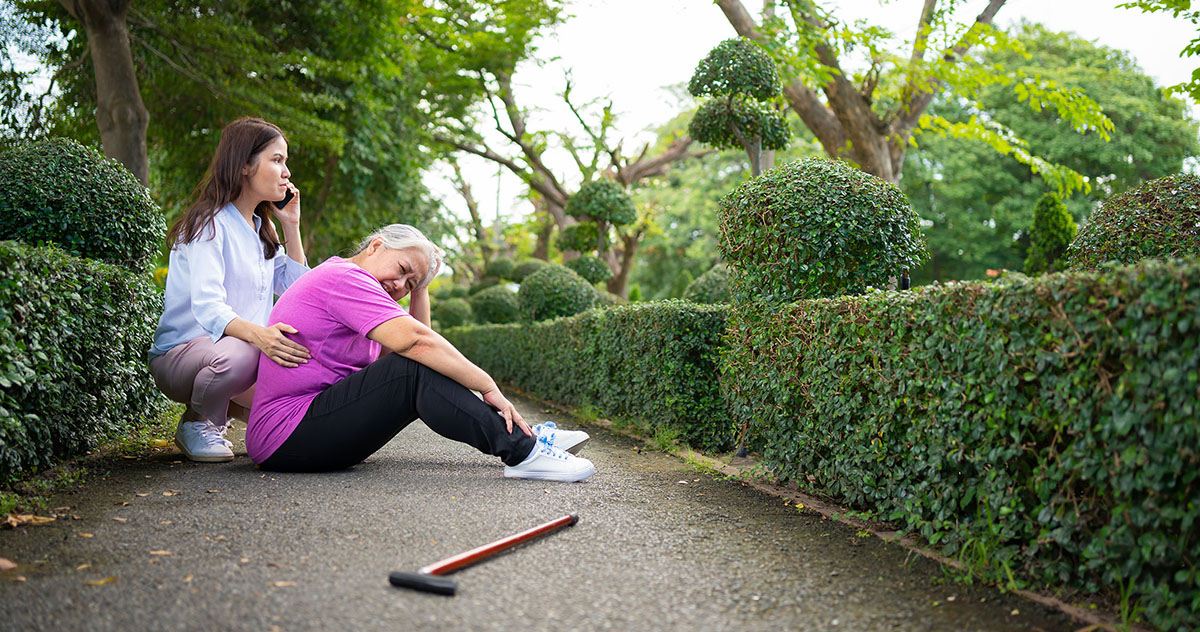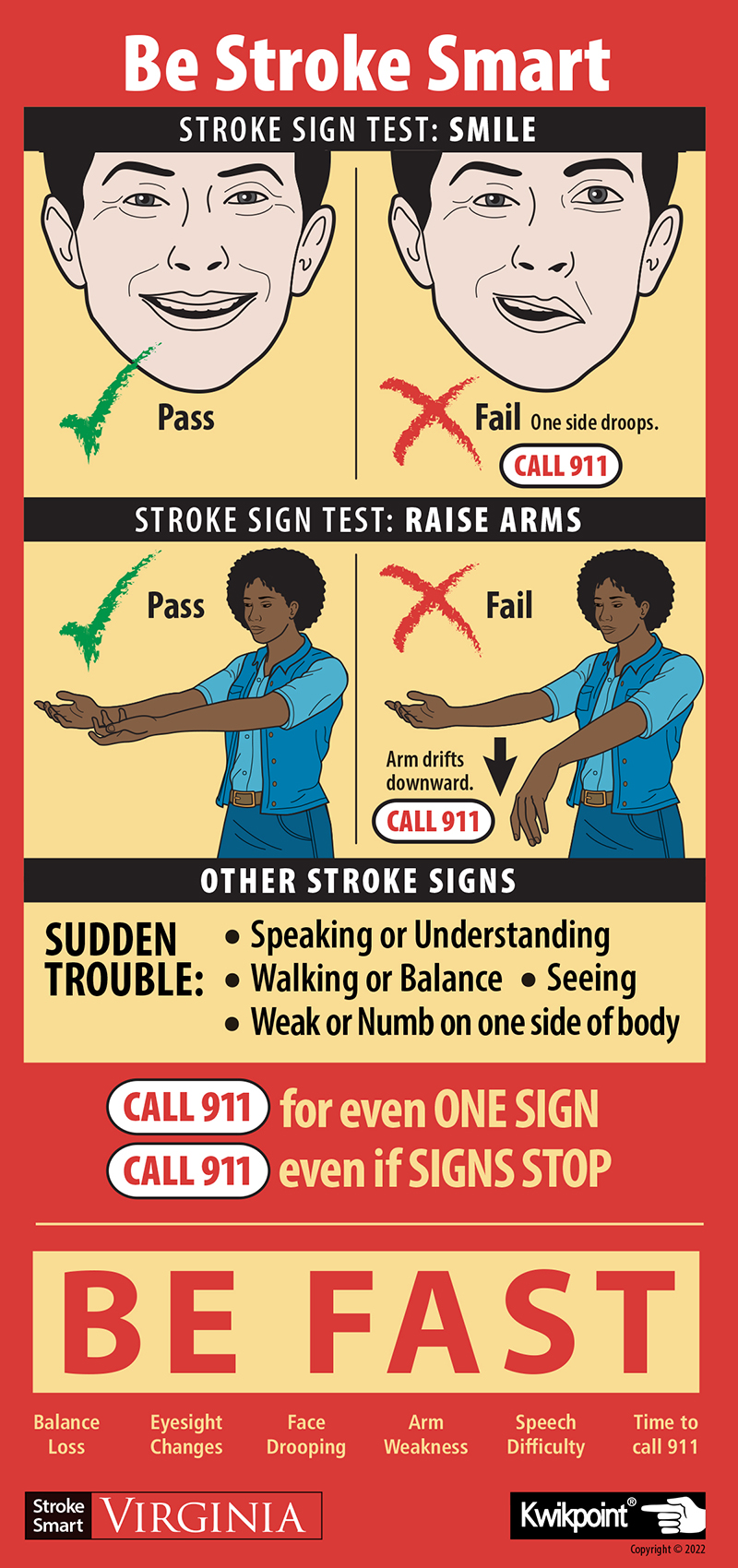Article by Gwen Jones, Department of Family Services
(Posted 2023 May)

 Did you know that strokes are the number one cause of disability and a leading cause of death in the United States? This is not surprising considering that one in six people will suffer a stroke during their lifetime. In the U.S., someone suffers a stroke every 40 seconds and someone dies of a stroke every four minutes. Although strokes can happen at any age, the chances increase as we age, so it is important to recognize the signs of a stroke and know what to do. Equally important is to share this information with family, friends, neighbors, and coworkers.
Did you know that strokes are the number one cause of disability and a leading cause of death in the United States? This is not surprising considering that one in six people will suffer a stroke during their lifetime. In the U.S., someone suffers a stroke every 40 seconds and someone dies of a stroke every four minutes. Although strokes can happen at any age, the chances increase as we age, so it is important to recognize the signs of a stroke and know what to do. Equally important is to share this information with family, friends, neighbors, and coworkers.
A stroke occurs when blood flow to the brain is interrupted. When this happens, brain tissue immediately begins to die, damaging the brain. Simply put, the signs and symptoms of a stroke are indications that brain damage is taking place. Thankfully, medication exists that can stop more damage from occurring, but only if it is administered soon after symptoms begin. Unfortunately, many people wait too long to seek treatment, often because they and those around them don’t recognize the signs of a stroke.
Signs of a Stroke
The signs of a stroke are not always clear, dramatic or obvious. Sometimes the signs are calm and subtle, causing people to delay seeking medical treatment. In such cases, people may attribute their symptoms to something else, such as fatigue, and take a nap. Others may schedule an appointment to see their doctor. These decisions can have catastrophic consequences.
The symptoms of a stroke can differ from person to person, but the most obvious sign of a stroke is the sudden and unexplained onset of the symptoms. Stroke symptoms vary depending on the part of the brain where the blood flow interruption occurs. For example, if blood flow is interrupted to the cerebellum, you may experience a loss of balance or dizziness, because that portion of your brain is responsible for motor control. 90-95% of stroke patients exhibit at least one of these symptoms:
- Loss of balance/dizziness
- Vision changes or loss of vision
- Facial drooping
- Body weakness on one or both sides
- Difficulty understanding or forming words, slurred speech
Approximately 60-70% of people experiencing stroke will display one-sided facial drooping or body weakness, but you can still be having a stroke without displaying either of those symptoms, so be aware of all the symptoms. You only need to be exhibiting one of the symptoms to be experiencing a stroke. You should also be aware that the symptoms of a stroke can stop and start. If they stop, you still need to seek treatment immediately.
What to Do (and Not Do) if You Suspect a Stroke
If you suspect that you, or another person, is having a stroke, immediately call 911. This is the best way to ensure that a person reaches the emergency room in time to receive effective treatment, increasing the chance of recovery.
Do not delay seeking treatment, hoping the symptoms will go away. Do not take a nap or make an appointment to see your doctor later. Every minute during a stroke, 2 million brain cells die. While you wait to seek treatment, your brain is dying.
If you think you are having a stroke, do not drive yourself to the emergency room. Call 911. Having a stroke means you are suffering brain damage, which makes you a danger to yourself and others on the road. A car crash will delay treatment if you are injured in a crash, and could injure others. Your stroke diagnosis could be delayed further as paramedics address your other injuries.
Do not drive others experiencing stroke symptoms to the emergency room. Call 911. Not all emergency rooms are equipped to treat strokes because of the special medication and training required, so you may take them to a location that is not equipped to provide treatment. By calling 911, you ensure that paramedics take the patient to the closest emergency room equipped to treat strokes. Paramedics will also communicate with emergency room staff en route, so they will be prepared to receive and treat the stroke patient immediately.
When speaking to medical personnel, be sure to advocate for yourself or a loved one using Stroke Smart language, e.g. “I am experiencing sudden onset facial drooping and dizziness.” If you feel like your symptoms are being dismissed by the doctor, don’t be afraid to ask for a different doctor.
Help Others be Stroke Smart

Considering how frequently strokes occur and the damage they inflict, you may assume that most people know to call 911 at the first sign of a stroke. However, only 38% of confirmed stroke cases called 911. In most of those cases, the calls were made by family, friends and coworkers, not the patient themselves, so it is vitally important that everyone in our community be Stroke Smart.
The first step is to have a Stroke Smart conversation with the people you spend time with, so they are able to recognize the signs of a stroke and know to call 911 immediately. Additionally, if you are a member of a congregation, civic group, or community organization, you can order free Stroke Smart BE FAST magnets or wallet cards to share. The magnets and wallet cards identify the signs of a stroke and instruct people to call 911 immediately if they experience or witness any of those signs. Bulk quantities of the magnets and cards are available in English and Spanish from the Virginia Department of Health using this link: vdh.Virginia.gov/stroke/chronic-disease-health-promotion-materials-order-form/
To learn more about strokes and the Stroke Smart campaign, visit the Northern Virginia EMS Council website at nvems.org.
This article is part of the Golden Gazette monthly newsletter which covers a variety of topics and community news concerning older adults and caregivers in Fairfax County. Are you new to the Golden Gazette? Don’t miss out on future newsletters! Subscribe to get the electronic or free printed version mailed to you. Have a suggestion for a topic? Share it in an email or call 703-324-GOLD (4653).

